skip to main |
skip to sidebar
I'm normally alert to any railways I may encounter in my travels but the significance of the location for a business meeting at Felin Fawr near Bethesda on Tuesday 22nd August 2023 (described in the post here) had failed to register until my friend said "There's an abandoned railway out the back!". After the meeting here wasn't much time to explore, but I made sure of a few pictures to prompt further study later. This post reports what I found.
I knew that the meeting location was near Penrhyn Quarry, which was once the largest slate quarry in the world. But I didn't know that Felin Fawr was the processing site for slate and the building which had hosted my meeting was formerly a Slab Mill producing sawn slate for building purposes. There are useful Wikipedia articles on the slate industry in Wales, the quarry and Felin Fawr Slate Works.

Railway sidings at Felin Fawr in 2023. The meeting was located in the building on the left.
Slate from Penrhyn was used locally from the 16th century but development of the industry in the 1770s was due to Richard Pennant (see 'Notes on the Pennant family' below). Initially, slate was carried in panniers by horse down the mountain to the docks at Port Penrhyn for onward shipment.
Around 1800 the Penrhyn Railroad was constructed, using oval rails fitted at 2 foot and half an inch centre-to-centre, apparently incorporating the somewhat earlier Llandegai Tramway. Haulage was by horses and the most difficult sections were provided with inclined planes operated as a gravity balance cable railway with two tracks. A cable attached to an ascending empty wagon wound around a drum at the top of the incline and attached to a loaded wagon descending means no external power was required. Control was provided by braking on the drum.
In 1878 the operation was transferred to a new, parallel railway using steam locomotive haulage throughout. The inclined planes were eliminated by deviations in the route, increasing route length but easing the grades. Trackwork was conventional and track gauge (measured in the normal way, between inner edges of rails) became 1 foot 10 3/4 inches. In this form, as the Penrhyn Quarry Railway, the system operated until 1962. In 2012, enthusiasts reinstated the trackwork around Felin Fawr which I'd found on my visit. Various galas and operating days were held between 2012 and 2017 when, sadly, the initiative ceased.
Wikipedia has notes on the railways and various cable railways There's an excellent, detailed history of the Penrhyn Quarry Railway in posts by Roger Farnworth here and here.
I also found three interesting articles and photographs by Graham Stephen about the Felin Fawr site. The first clarifies the layout of the Slate Mill. The second shows what remained around 2012 of a waterwheel which powered the mill. The third shows the locomotive shed during the sadly short-lived attempt to restore the railway as a preserved line. The waterwheel was of the suspended pattern, built by De Winton of Caernarfon (who also supplied some of the early steam locomotives for the Penrhyn Quarry Railway). An article by Steve Mills for the Gloucestershire Society for Industrial Archaeology here outlines the advantages of suspension water wheels and rim gearing.

Former Penrhyn Quarry Railway 'Blanche' restored (and heavily modified) at Festiniog Railway (Photo: A.M.Hurrell, CC BY-SA 3.0)
Notes on the Pennant family
Thomas Pennant (died 1522) was the Abbot of Basingwerk Abbey, Holywell. His grandson Gifford Pennant became a successful sugar planter in Jamaica. On his death the profitable sugar plantations, worked by slave labour, passed to Gifford's son Edward Pennant (1672-1736) who further developed the holdings whilst rising in the Jamaican establishment. On Edward's death, the estates passed to his sons John, Samuel and Henry (with care provision for a fourth son). Despite the family wealth, life in Jamaica could be challenging and the three brothers returned to England, leaving the plantations to be administered by agents and entered English society. John Pennant became a successful Liverpool merchant. Liverpool was, of course, the port of entry for Jamaican sugar. Samuel and Henry died without heirs, leaving their estates to John. Through a partnership in the salt trade with Colonel Warburton John became interested in the medieval estate of Penrhyn which was part owned by Colonel Warburton's wife. John, with his second son Richard Pennant (1739-1808), started buying up the remainder of the Penrhyn estate. Richard Pennant's political career started in 1761 when he became the Member of Parliament for Petersfield but, when a vacancy arose in Liverpool in 1767 he was returned unopposed. He married Colonel Warburton's daughter Anne Susanna in 1767.
Upon the death of John Pennant in 1781, the Penrhyn estate effectively became reunited, Richard inheriting part from his father and the balance through his wife. He also became absentee owner of the sugar plantations in Jamaica. In the election of 1780 he lost his seat in the House of Commons and was subsequently created !st Baron Penrhyn in 1783. Because this new creation was an Irish peerage, he was not allowed to sit in the House of Lords but able to stand for the House of Commons, allowing him to regain the Liverpool seat in 1784. Richard spoke in the House of Commons about trade and Liverpool concerns and remained opposed to the abolition of slavery. He was an enthusiastic supporter of projects to develop his Welsh estates and created the massive Penrhyn quarry. Previously, individuals would pay the landowner for the right to extract slate which was brought out by packhorses. Richard created an industry where the landowner took control of extraction and transport, paying employees a wage. He expanded the market for slate by building Port Penrhyn, Bangor, connected to the quarry by horse-drawn railroad.
On Richard's death in 1808, since he had no children, his Baronetcy lapsed and the ownership of the estates passed to his second cousin provided he added 'Pennant' to his name, becoming George Hay Dawkins-Pennant (1764-1840). George married for the first time in 1807 and had two daughters. He continued to develop the Penrhyn estate and received government compensation for the freeing of his slaves when slavery was abolished. In 1833, his elder daughter and co-heiress Juliana Isabella Mary Dawkins-Pennant married a Grenadier Guards officer, Edward Gordon Douglas (1800-1886).
By Royal licence, Edward Gordon Douglas changed his name to Edward Douglas-Pennant, allowing him to inherit the Penrhyn estate from his wife's father, George. In 1866 Edward Douglas-Pennant was raised to the peerage in a second creation of the title Baron Penrhyn, this time as an 'English' peerage. Developments at Penrhyn quarry and the Penrhyn estates continued. By his first wife, Juliana Isabella Mary Dawkins-Pennant, he had two sons and three daughters. During the 1868 general election, 80 quarry workers declined to vote for the Baron's son George who, at that time, was pursuing a political career and were sacked. After the death of his first wife, the 1st Baron re-married and had further children
The 1st Baron died in 1886 and his elder son George Douglas-Pennant (1836-1907) became the 2nd Baron, thereafter concentrating on the running of the various businesses. Penrhyn quarry workers went on strike in 1896, leading to closure of the quarry for 11 months. The 2nd Baron was unrelenting and the strikers resumed work on the same terms. A second strike in 1900 lasted for three years, earning 'The Great Strike of Penrhyn' a special place in the history of the Trades Union Congress. The 2nd Baron was clearly a complex man of strong convictions, hinted at in the biography in the Dictionary of National Biography. After reading about the turbulence of the nineteenth century, I decided not to pursue the Pennant history into the 20th century.
Notes on Penrhyn Castle
Penrhyn Castle was clearly important to the Pennant family and although externally the castle gives the appearance of being ancient, it is not. Between 1822 and 1837, the architect Thomas Hopper (1776-1856) created the imposing appearance. The castle is regarded as his finest work and listed Grade 1. As a National Trust site, it is open to the public and the former Stables houses a railway museum including Penrhyn Quarry Railway artefacts. There's an article about the railway museum on Wikipedia here and there's an entertaining record of the railway museum activities written by one of the former museum volunteers, Keith Jaggers, here. There's lots more about the Jagger's family history and Keith's interest in railways here. Over 2,000 documents from Penrhyn Castle have been archived at Bangor University, providing a valuable insight into transatlantic slave trade and plantation slavery. Dr. Marian Gwyn has researched these areas and there's an interesting article by her outlining the connection between Penrhyn Castle and slavery here.
List of referenced posts on other websites
Slate Industry in Wales (Wikipedia).
Penrhyn Quarry (Wikipedia).
Felin Fawr Slate Works (Wikipedia).
Penrhyn Quarry Railway (Wikipedia).
Cable railway (Wikipedia).
Penrhyn Quarry Roger Farnworth: Penrhyn Quarry Railway (Part 1).
Penrhyn Quarry Roger Farnworth: Penrhyn Quarry Railway (Part 2).
Suspension water wheels and rim gearing
FELIN FAWR WORKS Graham Stephen (GeoTopoi).
FELIN FAWR WATERWHEEL Graham Stephen (GeoTopoi).
FELIN FAWR LOCOMOTIVE SHED Graham Stephen (GeoTopoi).
Richard Pennant, 1st Baron Penrhyn (Wikipedia).
George Hay Dawkins-Pennant (Wikipedia).
Edward Douglas-Pennant, 1st Baron Penrhyn (Wikipedia).
George Douglas-Pennant, 2nd Baron Penrhyn (Wikipedia).
The great Penrhyn quarry strike (TUC).
Dictionary of National Biography, 1912 supplement.
Penrhyn Castle (Wikipedia).
Thomas Hopper (architect of Penrhyn Castle) (Wikipedia).
Penrhyn Castle Railway Museum (Wikipedia).
Penrhyn Castle Railway Museum: Vol 2 (Keith Jaggers).
Keith and Elizabeth Jaggers Family Heritage.
Penrhyn Castle and Slavery (Dr. Marian Gwyn).
My pictures
My pictures at Felin Fawr Cyf (showing the reconstructed trackwork) are here.
I'd agreed to attend a business meeting near Bangor on Tuesday 22nd August, 2023. The people we're working with on this project were travelling from the south-west on Monday to be at the meeting and they suggested that we might travel together by car and that they would collect me around 1 p.m. This allowed me to work in the office in the morning, before they arrived at lunchtime.
The weather was good, so there was time for a brief tour of the garden and the Hall before we set-off together. It was agreed that we'd take the 'pretty route', using the A5 through Llangollen. Since this would take us near the commercial woodland at Ty Gwyn, it was further agreed that we'd make a short detour to Ty Gwyn as neither of my friends had previously visited the plantation.
After a pleasant journey, the weather remained mild on arrival at Ty Gwyn and we were able to explore the forest roads on foot.
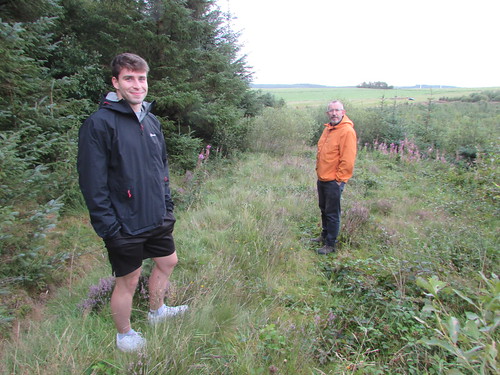
Alex and Steve at Ty Gwyn 2023
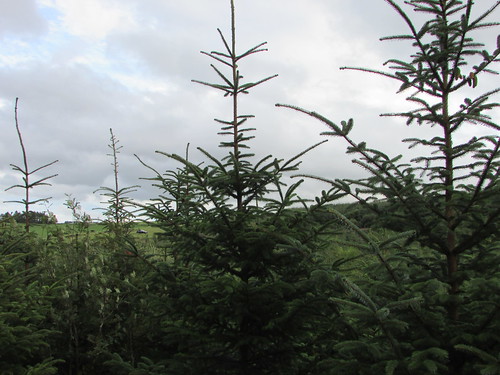
Ty Gwyn 2023: Progress achieved by the sitka spruce which was replanted in 2016.
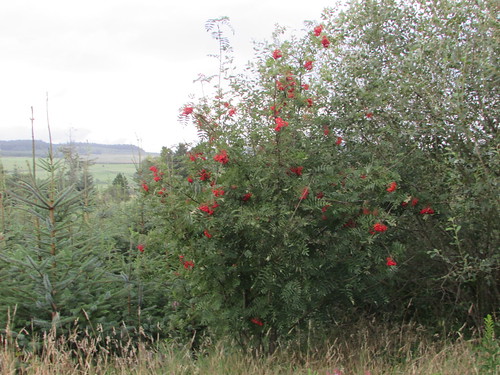
Splendid Rowan berries: Ty Gwyn 2023
Leaving Ty Gwyn, we headed on through the spectacular scenery around Snowdonia as the weather rapidly deteriorated. Having negotiated heavy rain, conditions improved as we approached Bangor at dusk. Overnight accommodation had been arranged at The Management Centre operated by Bangor University. The main university campus at Bangor is at the summit of a hill overlooking the town and the Menai Strait. The Management Centre is a Residential Training, Conference and Events Venue housed in three buildings built in 1910 on the slope below the main campus. After restoration and refurbishment, these three buildings were re-opened with their present role in 2010. My pleasantly-situated room in one residential block gave a view of the main Management Centre building to the left, faced a similar residential block and revealed the Menai Strait looking to the right.

Main Management Centre building, Bangor

View of the Menai Strait from The Management Centre, Bangor
We'd arrived early enough to take dinner in the '1884' restaurant at The Management Centre (1884 was the founding date of Bangor University). Informed that fish had run out (my usual choice), I opted for vegetarian tagliatelle which was very good. After the enjoyable meal with my friends, I was happy to retire to my well-appointed bedroom for a good night's sleep. On Tuesday morning, we took the buffet breakfast at the '1884' before setting off for our meeting.

Bedroom at The Management Centre, Bangor
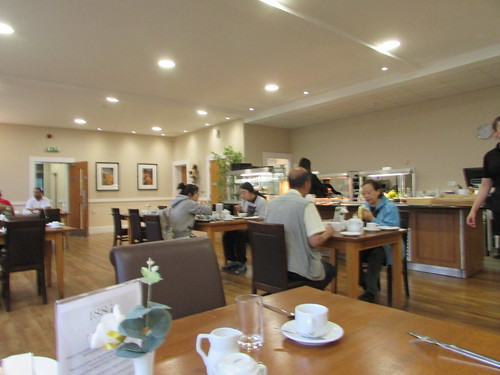
Breakfast at '1884' Restaurant, The Management Centre, Bangor
Since our meeting was scheduled to last all day, we made a brief stop on the way at the large Marks and Spencer's supermarket to select sandwiches, snacks and drinks to sustain us. The meeting was near Bethesda at Felin Fawr Cyf. Here, a series of early industrial buildings have been converted into 'Units' for small business use. Concentrating on the business of the meeting, my antenna failed to alert me to the significance of the location until Steve said "There's an abandoned railway out the back!". When the meeting finished, Steve was hoping to drive back to South Wales, dropping me off on the way so there wasn't much time to explore, but I made sure of a few pictures to prompt further study later. I was puzzled that the truncated trackwork, with a gauge of around two feet, included some modern sleepers, indicating fairly recent (say within 10 years) maintenance. Well, that was a puzzle for the future. I was returned home safely by car after an interesting couple of days and eventually added a post about the Penrhyn Quarry Railway here.

Railway sidings at Felin Fawr
Related posts on other websites
The Management Centre, Bangor.
Related posts on this website
My posts on Brewood Hall are here.
My posts on Ty Gwyn are here.
My pictures
My pictures of Brewood Hall are here.
My pictures of Ty Gwyn are here.
My pictures of The Management Centre are here.
My pictures at Felin Fawr Cyf (showing the reconstructed trackwork) are here.
[Link to Penrhyn Quarry Railway post added 31-Oct-2023]
On Monday 12th June 2023, I visited the former Nant Helen Opencast and associated Onllwyn Washery site (extending to 550 hectares) which is to become the Global Centre of Rail Excellence (GCRE) in South Wales to attend their 'Open Day'. I travelled by rail to Newport the previous day with an overnight stay in Newport (described here). before the 'Open Day' visit.
A liitle background
The geology of Wales gave the country massive deposits of coal and other minerals. Initially, early tramroads were used to assist extraction but the growth of steam power (in manufacturing, railways and steamships) increased demand and led to a series of railways being created. The Dulais Valley had a number of mines, giving rise to various local iron and copper works.
Over time, underground mining gave way to opencast mining. Excavators first remove topsoil which is taken away by large dump trucks (called 'Haulers') and stored in soil mounds to be reused when mining is complete. Excavators then remove the unwanted material ('overburden') to access the coal-bearing layers beneath, resulting in a large pit or void, equipped with a network of roads allowing the coal extracted by excavators to be hauled away. Remediation of areas once extraction ceases can start in some areas even as opencast mining continues in others.
Until 2022, coal from Nant Helen was loaded onto rail wagons at Onllwyn Washery and carried away using the former Neath and Brecon Railway. The refusal by the Coal Authority (a non-departmental public body sponsored by the Department for Energy Security and Net Zero) to issue a license for continued extraction forced closure of the mine and Washery and the railway was mothballed.
The Welsh Government, Powys County Council and Neath Port Talbot County Council developed an ambitious scheme to convert the Nant Helen site into a world-class test site for railway rolling stock and advanced railway infrastructure construction techniques called Global Centre for Rail Excellence (GCRE). GCRE will compete with existing facilities at Wildenrath, Velim and Old Dalby (Wikipedia)
The Open Day
Invitees to the open day were representatives from organisations who'd been involved in Innovate UK Phase 1 Bids at the site and were interested in bidding for further support on twelve projects during Phase 2 of this project. The meeting point was Onllwyn Welfare Hall (formerly Onllwyn Miners' Welfare Hall). After brief introductions given by GCRE staff, participants were divided into a number of parties to be escorted on a tour of the site using a fleet of Land Rovers. The site of GCRE is currently a building site where remediation work is being carried out using heavy plant, so the Construction (Design and Management) Regulations 2015, usually referred to as 'CDM Regs', apply requiring invitees to use full Personal Protective Equipment (PPE) during the tour.

GCRE: Onllwyn Welfare Hall, GCRE 'Open Day'
The Land Rovers were lined up in the car park outside the Welfare Hall and, once loaded, a short drive on public roads took us to the road overbridge where the currently-disused single-line railway from Neath enters the Nant Helen site near Onllwyn Washery.

GCRE: View from bridge over railway on Onllwyn Road, looking towards former Washery. Note trap points, operated from single-lever ground frame incorporating a keylock

GCRE: View from bridge over railway on Onllwyn Road, looking towards Neath. In the distance, note the level crossing on an internal site road formerly used by mining vehicles.
We then continued on a surfaced internal site road towards the offices of the former opencast complex.

GCRE: Land Rover Site Tour approaching offices/car park through land restored L: 1995-2000 R: 1980-1990

GCRE: Land Rover Site Tour passing the Offices/Car Park
We continued past the offices to the northern boundary of the site where we stopped to see the result of remediation work, including tree planting, carried out between 1993 and 1998.

GCRE: Land Rover Site Tour paused to show the land towards the north of the site restored between 1993 and 1998.
Looking north, there were impressive view towards the Brecon Beacons with Abercrave village in the foreground (served by the A4221 road hidden in the trees).

GCRE: Land Rover Site Tour showing Abercrave to the north of the site.
The Land Rovers returned to the office complex and turned west, past rows of parked heavy plant left and right and what I assumed were the vehicle maintenance workshops. From here, we continued on what had been named the Haul Road - a feature of mining sites where massive vehicles bring back the extracted material from the working face to a central point for processing or distribution. Some heavy plant was in use but many vehicles appeared to be in store. Presumably some of the plant previously used in the extraction of coal has been re-purposed for the ongoing remediation work.

GCRE: Land Rover Site Tour showing tracked excavators in store. They appear to be Komatsu PC 2000. CAT 'Dozers' are also parked
Our Land Rovers started to prove their worth as we entered a grey 'moonscape' where the surface, frequently wide enough for a motorway, had been rolled but not surfaced.
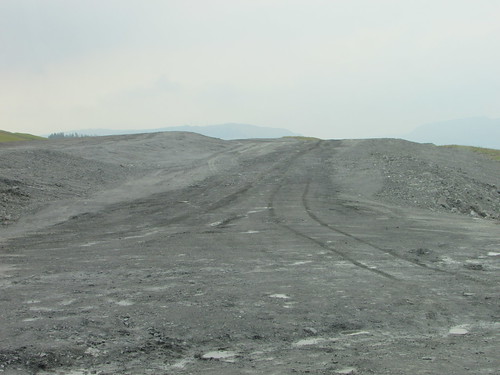
GCRE: Land Rover Site Tour on the Haul Road

GCRE: Land Rover Site Tour showing a 20-ton tracked excavator (JCB 220X LC) operated by Walters with a number of Volvo A30G Articulated Haulers parked
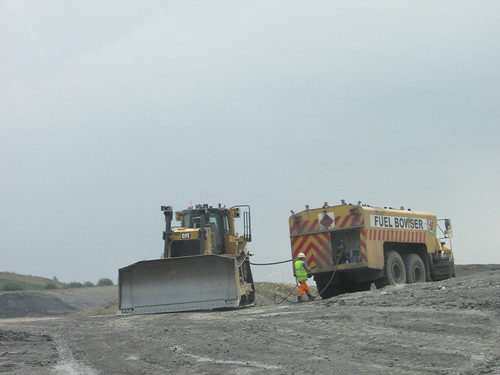
GCRE: Land Rover Site Tour on the Haul Road showing a CAT 'Medium Dozer' being refuelled from a Fuel Bowser

GCRE: Land Rover Site Tour passes a Volvo A30G Articulated Hauler ('Dump Truck') which can carry a 29 tonne net load
I was fascinated as we approached an unfamiliar-looking tracked machine being loaded onto a trailer. By the time we passed the scene, the machine had been left halfway up the trailer ramp. It appeared to be a drilling rig but, knowing nothing of groundworks, it took a little searching to conclude it was a Eijkelkamp Fraste CRS XL140 DUO multi-purpose sonic rig.

GCRE: Land Rover Site Tour on the Haul Road with plant at work and Drilling Rig about to be loaded onto low loader hauled by tractor
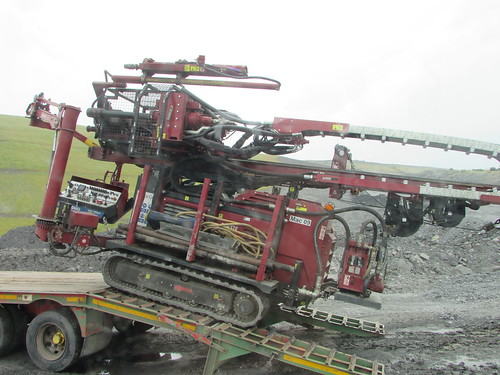
Eijkelkamp Fraste drilling rig: It appears to be a CRS XL140 DUO multi-purpose sonic rig (GCRE)
Mining operations had left a large Void and the tour paused to allow the appearance, somehat softened by remediation work and fringed by spruce trees, to be viewed.
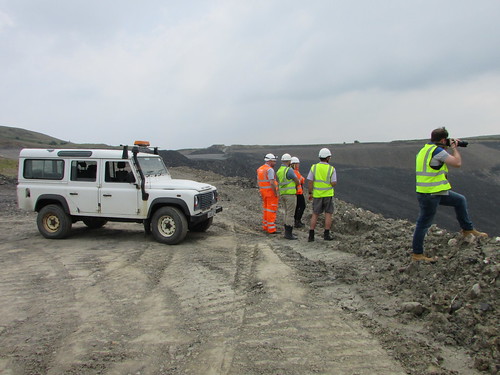
GCRE: Land Rover Site Tour paused to view the Void

GCRE: Land Rover Site Tour at The Void
At the highest point on the site, we passed a battered-looking self-supporting telescopic antenna which had been used for site communication using hand portables or private mobile radios.

GCRE: Land Rover Site Tour passes a rather battered transmission tower which supported site communications
The Land Rovers then returned us to the Welfare Hall for welcome refreshments.

GCRE: Onllwyn Welfare Hall, GCRE 'Open Day'
In the afternoon, we had a walking tour, proceeding on foot to the railway bridge on Onllwyn Road. After some discussion regarding the planned work to renew the rusting structure and adjust the railway track level, we took the internal site road to the level crossing on the Neath site of the bridge. It looked as if the level crossing and associated site roads had been provided to allow heavy road traffic from the mine to reach the Washery without crossing the rather fragile-looking road bridge.
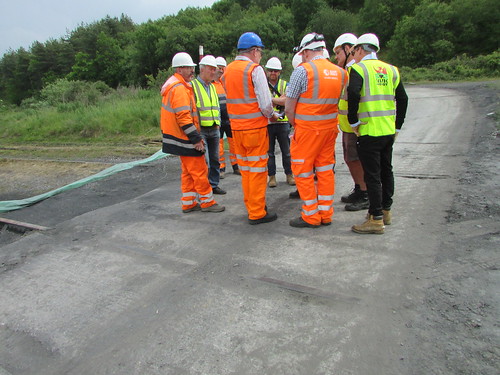
GCRE: Washery-Depot Area Walking Tour, GCRE Open Day, showing party joining the branch line at the level crossing
The tour continued along the railway track towards the Washery, passing under the Onllwyn Road bridge.

GCRE: Washery-Depot Area Walking Tour, GCRE Open Day, showing Onllwyn Road bridge with stone-built pediments.
We passed the original trap points, operated from a key-locked single-lever ground frame, which controlled movements from the Washery area onto the single line to Neath. Two original turnouts remain, as the single line fans out, but further on all permanent way has been lifted with a few panels of track neatly piled.

GCRE: Washery-Depot Area Walking Tour, GCRE Open Day, showing two turnouts and stop block. Note spare track panels in background.
Beyond here, the original sidings have been lifted and earthworks have been carried out, leaving a solitary abandoned CCTV camera (fitted in what appears to be a Dennard pan and tilt housing with windscreen wiper).

GCRE: Washery-Depot Area Walking Tour, GCRE Open Day, showing abandoned CCTV camera. Note tripod for surveying equipment in background.
Although the walking had tired me, it was disappointing that we didn't go further into the Washery area but instead cut through a car park near the security building and site entrance from Onllwyn Road to regain the public road and return to the Welfare Hall.
An unusual and absorbing visit.
Introduction to other Test Centres on other websites
Wegberg-Wildenrath Test and Validation Centre (Wikipedia)
Velim test centre (Wikipedia)
VUZ TEST CENTRE VELIM
Old Dalby Test Track (Wikipedia)
The Old Dalby Test Track
Related articles on other websites
History of Onllwyn Collieries (Welsh Coal Mines)
Global Centre for Rail Excellence (Wikipedia)
Eijkelkamp Fraste CRS XL140 DUO
Coal Authority (Wikipedia)
Related posts on this website
By Train to Newport (Getting to Wales for the Open Day)
My pictures
GCRE.































